
Vaginitis: What is it?
Vaginitis: What is it? Normal vaginal discharge is clear to whitish and non-irritating (it varies depending where you are in your cycle). If this changes, there may be a problem. There are several different things that can cause inflammation or discharge in the vagina. Vaginitis is a wide-ranging term that covers all of them. Inflammation of the vagina or vulva is a common cause of discomfort and discharge (it is the most common reason women go to the doctor). It can be caused by bacterial overgrowths, yeast or by a parasite called Trichomoniasis (Trich). Trich is often (but not always) sexually transmitted. Yeast & Bacterial Vaginosis are NOT STIs. Sometimes STIs like Chlamydia or Gonorrhea can cause discharge. Because there are several things that can cause Vaginitis, treatment for one won’t work for another. That’s one reason why we want you to come in to get tested. While many of these infections can be harbored in men, they usually have no symptoms and aren’t as serious. In general, the main culprits in causing Vaginitis are: Antibiotics can kill off the healthy bacteria (lactobacilli) that keep a balance in your vagina. Wearing tight, non-breathable clothing makes it easier for the harmful bacteria and yeast to multiply. Cotton undies help to keep things breathable and dry. Thong underwear can make it easier to get an infection because of irritation. Allergic reactions to things like the inks, dyes and chemicals in many toilet papers, detergents, douches, bubble baths, soaps, pads and tampons can irritate the skin and cause inflammation. Condoms that are lubricated with a spermicide often cause irritation which can lead to a vaginal infection (they also don’t contain enough spermicide to be helpful). Your best bet is to use a condom lubricated with a non-spermicidal lubricant or add your own lubricant. It should be water based, like Astro-glide, or Wet. Oil based products (Vaseline, hand lotion) break down the latex in a condom pretty quickly. Some people have an allergy to latex. Try different kinds of condoms and lubricants to see what works for you. Injury; mostly from too much friction and not enough lubrication during sex. Injury can also occur from clothes that are too tight or uncomfortable. Diet; the better you eat, the stronger your immune system and the more likely your own body will be able to ward off infections on its own. Hormones can make it easier to get infections during different times of your cycle or with different kinds of birth control. Also pregnant women tend to get increased yeast infections. It is easier to get sexually transmitted infections when you have any infection such as Vaginitis because it lowers your natural protective mechanisms and immunity. People with certain Diseases, like HIV and diabetes, and those confined to wheelchairs are also at higher risk for infection. Prevention There are things that you can do to prevent Vaginitis; Wear cotton underwear. Avoid tight pants, thongs, synthetic underpants, pantyhose, tights, etc. Wipe from the front to the back. Keep your genital area clean and dry (no damp swimsuits for hours). Use non-scented and non-dyed products in and around your vagina and labia (toilet paper, clothes detergent, soap, etc.). Limit your number of sex partners. Don’t douche or use feminine deodorant products ever. The vagina naturally cleans itself – you don’t need this junk. Use non-spermicidal lubricated condoms. Use additional lubricant for sex. Practice safer sex. Change pads and tampons every 4 hours. Don’t have sex while being treated or when you have symptoms. Take care of yourself: eat well, sleep well, don’t fret and don’t smoke, drink or do drugs. Diagnosis You will be asked questions to see what symptoms you have noticed. A pelvic exam is often done to look for physical signs of various infections. Also, a sample of discharge is usually taken and sent to the lab where it is looked at under a microscope. At the Annex we will also test you for Chlamydia and Gonorrhea to make sure they aren’t causing the problem. Bacterial Vaginosis Bacterial Vaginosis (B.V.) is an overgrowth of bacteria in the vagina. B.V. is often called Gardnerella for a bacteria that can cause it, but many kinds of bacteria can be the culprit, and we usually don’t know what bacteria it is. Bacterial Vaginosis is being taken more seriously than it was in the past. It is associated with pelvic inflammatory disease (P.I.D.), which is a serious infection in your uterus that can lead to infertility and even death if not treated. B.V. is linked to pre-term labor and low birth-weights with pregnancy, and it can cause infections with gynecological surgeries. For these reasons (as well as being uncomfortable) it is important to nip B.V. in the bud and treat it. The most common symptoms are: An increase in vaginal discharge. Usually whitish gray or yellowish in color. A fishy smell that often worsens during your period or after sex (when semen mixes with vaginal fluid it makes it easier for the bacteria to grow). Itching or burning around your vagina. B.V. is treated with prescription medications. Yeast Infection Is an infection caused by an overgrowth of yeast (don’t be grossed out, there’s always some yeast in your vagina but it’s kept from overgrowing by the other bacteria that are normally present). The usual symptoms of a yeast infection are: A thick, chunky, white discharge. Smells like bread or has no odor. Burning, itching and irritation. Redness or swelling of the labia. Yeast overgrows easily in a warm, moist environment (like wet swimsuits). Although yeast infections can be very uncomfortable, they haven’t been linked to any serious health risks. Yeast infections can be treated with over the counter vaginal creams, or at the clinic with either a vaginal cream (you may need a prescription) or a pill. You can make yourself more comfortable with external creams like Vagisil, or one provided with the treatment. Also, eating plain yogurt can help prevent yeast infections. Trichomoniasis a.k.a. Trich Is caused by a parasite. It’s usually a sexually transmitted disease, but it can also be spread though sharing towels or swimsuits, baths with an infected person or hot tubs. The usual symptoms are: Yellow, green or gray frothy or sticky discharge. Foul odor. Itching in and around the vagina. Spotting between periods. Frequent urination. Painful intercourse. Trich is treated with a prescription. VAGINITIS What causes weird vaginal discharge and what to do about it. Non-Infectious Vaginitis This is when the symptoms of Vaginosis are there (vaginal irritation, increased discharge or pain with sex) but there isn’t an infection present. This is usually caused by a reaction to a product or injury to the area. To get rid of it, the main goal is to figure out where the irritation comes from and avoid the source. Comfort measures like over the counter creams (Vagisil) can help. Cervicitis Cervicitis is inflammation or infection of the cervix (the bottom of the uterus, or where your vagina ends). It’s usually caused by a sexually transmitted infection. It can lead to pelvic inflammatory disease, abnormal pap smears and infections during pregnancy. The symptoms are often like Vaginitis symptoms. They may include: Spotting between periods. Vaginal discharge. Bleeding after sex. It is usually treated with a prescription. Bacterial Vaginosis Yeast Cervicitis Trichomoniasis Non-Infectious Vaginosis Finally Call a clinic if you have any changes in vaginal discharge, odor, lower abdominal pain, bleeding between periods or irritation. Many things can cause Vaginitis and the results may be dangerous if you don’t treat the right infection. Get tested to make sure you are treating the right infection. Call us with any questions. 4915 42nd Avenue North Robbinsdale, MN 55422 763-533-1316 www.annexteenclinic.org
© Copyright 2025


















